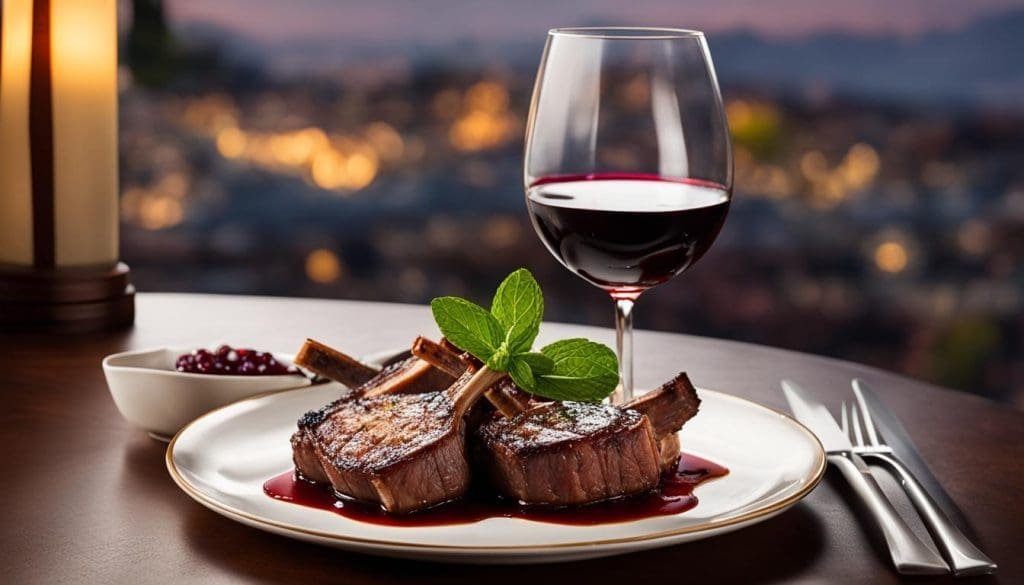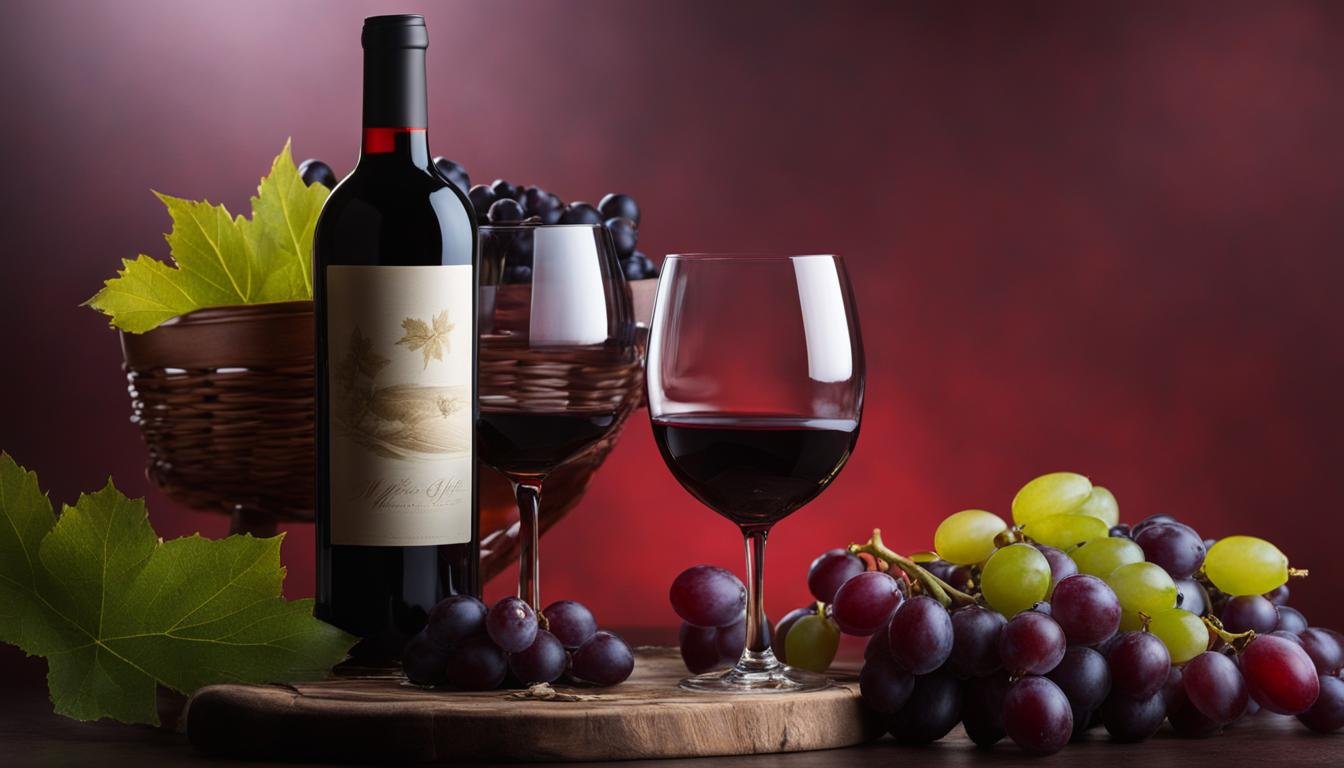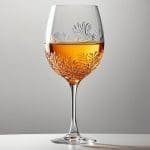This post may contain affiliate links. Please read my disclosure policy.
If you’re looking to indulge your taste buds with a smooth, dry, and fruity red wine Merlot, you’ve come to the right place. This popular wine has maintained its appeal, even amidst the cultural storm stirred by the film “Sideways.” Its delightful flavour profile, brimming with notes of black cherry, blackberry, plum, and raspberry – all enhanced by herbal, vanilla, and mocha undertones – makes it a star at any wine tasting event. Merlot, originating from France’s Bordeaux region, has gracefully adapted to various wine-growing areas such as Tuscany, Napa Valley, Sonoma County, and Australia. So, sit back, relax, and let us guide you through the captivating world of Merlot wine characteristics.
Key Takeaways
- Merlot is a smooth, dry, and fruity red wine that has remained popular despite pop culture influences.
- Originating from France’s Bordeaux region, Merlot now thrives in various wine-growing areas across the globe.
- The wine boasts a medium-to-full body and moderate acidity, with alcohol content typically between 13.5% and 14.5% ABV.
- Its flavour profile features black cherry, blackberry, plum, and raspberry notes, with hints of herbal, vanilla, and mocha undertones.
- Merlot is a versatile wine that can be crafted into both single-varietal wines and blends, catering to various tastes and preferences.
Merlot Overview: An Introduction to the Wine Enthusiast’s Favourite
Merlot has steadily captured the hearts of wine enthusiasts worldwide with its signature dry, velvety palate and juicy fruit flavours. Renowned for its approachability at various price points, this popular Merlot varietal offers wine drinkers a captivating experience. The hallmark taste of Merlot features a symphony of black fruits, including black cherry and plum, which are often enhanced by oak ageing processes to introduce warmth and spices such as vanilla and mocha. With historical origins in Bordeaux, this grape, often pronounced with a soft ‘mer-low,’ resembles blackbirds and now enjoys global acclaim.
Esteemed wine regions such as Washington’s Columbia Valley and Italy’s Toscana have embraced Merlot, providing wine drinkers with varying expressions from medium to full-bodied profiles. These expressions are defined by a medium acidity and soft tannins that make this varietal a wine enthusiast’s favourite.
Merlot has found its place in both wine blends and single-varietal Merlot expressions, further highlighting its versatility and appeal. In this section, we’ll explore the characteristics that have cemented Merlot’s status as a beloved varietal in the wine world.
“Merlot offers wine drinkers a captivating experience, featuring a symphony of black fruits, warmth, and spices.”
Merlot’s versatility is showcased through its compatibility in wine blends and its ability to shine as a single-varietal wine:
- Bordeaux blends: Often used as a blending partner with Cabernet Sauvignon, Merlot adds roundness and fleshiness to the blend, softening the tannins and enhancing the fruity character.
- Single-varietal Merlot: The grape’s unique expression is embraced in regions like Washington’s Columbia Valley and Italy’s Toscana, where winemakers craft full-flavoured, smooth, and complex Merlot wines that captivate the palate.
The allure of Merlot continues to gain traction as wine lovers worldwide savour its distinctive taste and an extensive range of expressions. With a multitude of options available from various wine-growing regions, Merlot remains a staple favourite among both novice and experienced wine enthusiasts alike.
Profile of the Merlot Grape Variety: Understanding its Unique Characteristics
The versatile Merlot grape variety is largely influenced by its regional growth conditions, with each region manifesting its distinctive taste profile. In this section, we discuss the regional influence on Merlot and its flavour notes, followed by Merlot’s relationship with its structural elements – tannins, acidity, and body.
The Regional Influence and Flavour Notes of Merlot
Merlot’s taste profile, ranging from lush fruitiness to earthy elegance, varies significantly across different wine-producing regions. The milder climates of Bordeaux and Northern Italy give rise to Merlot wines with notes of violet, tobacco, and earthiness. In contrast, warmer regions like California and Australia accentuate the grape’s fruit-forward nature, with flavours of plum, berries, chocolate, and assorted baking spices, courtesy of oak aging.
Table 1: Regional Influence on Flavour Notes of Merlot
Region Major Flavour Notes
Bordeaux (France) Primary flavours of Merlot from Bordeaux are soft and velvety, with notes of black cherry, plum, cassis, chocolate, and often a touch of oak.
Pomerol and St.-Emilion (France) Pomerol and St.-Emilion are known for producing some of the most full-bodied and tannic Merlots in the world. Flavours of blackberry, dark chocolate, and coffee are common, with ageing in new oak barrels lending flavours of vanilla and toast.
Tuscany (Italy) Merlots from Tuscany often have bright red fruit flavours of cherry and raspberry, with soft tannins and good acidity. Secondary flavours can include earthy notes of tobacco and leather, along with spices like black pepper and cloves.
Napa Valley (California, USA) The climate and terroir of Napa Valley is well-suited to producing full-bodied Merlots with ripe, concentrated fruit flavours. Common flavour notes include blackberry, currant, plum, chocolate, and vanilla.
New Zealand New Zealand Merlots often have intense aromatics featuring lifted floral and herbaceous notes. On the palate, look for flavours of dark berries, plums, and chocolate, balanced by moderate acidity and fine-grained tannins.
South Africa South African Merlots tend to be more medium-bodied, with fresh red fruit flavours of cherry and raspberry. Secondary notes can include spices like black pepper and cloves, along with earthy notes of tobacco and leather.
Australia Australian Merlots are typically medium to full-bodied, with ripe fruit flavours of plum, blackberry, and currant. Oak ageing lends secondary flavours of toast, vanilla, and spice.
Pairing Merlot with food
Merlot is a versatile grape that can be paired with a wide variety of foods. The soft tannins and moderate acidity make it a good choice for pairing with red meats, while the fruit-forward nature of the grape makes it a good match for dishes with tomato-based sauces. The plum and chocolate flavours of Merlot also make it a good partner for richer poultry dishes like duck or game hen. When choosing a wine to pair with food, it is important to take into account the weight and intensity of both the wine and the dish. A full-bodied Merlot can stand up to rich, hearty dishes, while a lighter Merlot will be overpowered by these same dishes. Conversely, a rich, hearty dish can help to soften the tannins in a full-bodied Merlot, making the wine more approachable.
The ideal temperature in Fahrenheit for Merlot is 55-60 degrees.
| Region | Climate | Primary Flavour Notes |
|---|---|---|
| Bordeaux and Northern Italy | Mild | Violet, Tobacco, Earthiness |
| California and Australia | Warm | Plum, Berries, Chocolate, Baking Spices |
Such regional influences contribute significantly to the Merlot taste profile and the sensory experience offered by each wine.
Merlot’s Relationship with Tannins, Acidity, and Body
The profile of the Merlot grape variety also depends on its relationship with structural elements like tannins, acidity, and body. Typically, Merlot grapes have medium acidity and soft, velvety tannins, contributing to their medium-to-full body. These features make Merlot a more approachable and accessible red wine compared to variants like Cabernet Sauvignon, which can exhibit stronger tannins and more pronounced acidity.
“Merlot’s balance between fruity flavours, structural elements of tannins and acidity, and its medium-to-full body make it a favourite choice among both novice and experienced drinkers.”
In summary, the characteristics of the Merlot grape variety are shaped by a combination of regional influences and its relationship with structural elements. Understanding these factors contributes to a deeper appreciation of the complex profile of Merlot wines and their unique sensory experiences.
The Viticultural Canvas: Growing Regions, Climate, and Soil Conditions for Merlot
Merlot grapes are known for their incredible versatility, thriving in various growing regions stretching across the globe. Each region hosts unique climate and soil conditions that significantly influence the final taste profile of Merlot wines.
From its origins in France’s Bordeaux region to flourishing wine-producing areas in Tuscany, Napa Valley, Sonoma County, and Australia, Merlot grapes make their mark with distinct characteristics and flavour profiles influenced by local terroir.
Climate for Merlot plays a crucial role, as the grape adapts well to both cool and warm climates. In cooler regions like Bordeaux and Northern Italy, Merlot typically produces wines with pronounced acidity and herbal flavours. Warmer climates, such as California and Australia, yield Merlot wines with higher alcohol content, richer, jam-like fruit flavours, and a fuller body.
Another critical factor shaping Merlot’s distinct features is soil conditions for Merlot. Well-drained sandy soils are particularly suitable for these grapevines, as they impact Merlot’s colour, which ranges from dark red to red-brown, and contribute to the wine’s characteristically smooth texture.
How Climate Variances Affect Merlot’s Taste Profile
As we’ve seen, climate variances play a significant role in shaping Merlot’s taste profile. To gain a clearer understanding of these variances, let’s dive into some notable differences in Merlot wines from various regions.
| Region | Cool or Warm Climate | Taste Profile |
|---|---|---|
| Bordeaux, France | Cool | Higher acidity, herbal flavours, notes of tobacco and earthiness |
| Northern Italy | Cool | Herbal characteristics, violet and tobacco notes |
| Napa Valley, California | Warm | Lush fruit-forward flavours, hints of chocolate and baking spices |
| Sonoma County, California | Warm | Jammy fruit notes, accentuated by oak-based complexity |
| Tuscany, Italy | Variable | Red fruit flavours, varying acidity and tannins depending on microclimate |
| Australia | Warm | Rich fruit flavours, higher alcohol content, fuller body |
Understanding the impact of climate variances on the taste profile of Merlot can help wine enthusiasts appreciate the full spectrum of flavours and styles available within this popular varietal. From elegant, herbaceous cool-climate wines to fruit-forward expressions in warmer regions, the diverse characteristics of Merlot are a testament to its adaptability and timeless appeal.
The Production Journey: From Vineyard to Bottle
The journey of Merlot from vineyard to bottle is a complex and intricate process that begins with the careful harvesting and pressing of grapes. Depending on the desired end product, winemakers will decide between creating a single-varietal or blended Merlot, tailoring fermentation and aging processes accordingly.
Merlot’s adaptability as a blending partner or standalone varietal showcases its role in both iconic Bordeaux blends and contemporary single-varietal expressions. Oak ageing plays a crucial part in adding rich flavour and smoky notes of vanilla and cocoa to the varietal.
The Merlot winemaking process demonstrates an artful balance between tradition and innovation, showcasing this varietal’s versatility and enduring popularity.
The production journey of Merlot can be divided into several main steps:
- Harvesting and Crushing
- Fermentation
- Blending (when applicable)
- Aging
- Bottling
Each step contributes to the unique characteristics and flavours that define Merlot wine.
Harvesting and Crushing
The initial stage in viniculture involves hand-harvesting grapes at their optimal ripeness to ensure the best possible flavour. The grapes are then taken to the winery for crushing, during which grapes are pressed to release their juices, followed by the removal of stems and seeds.
Fermentation
Once the grapes are crushed, fermentation begins. Yeast is added to the grape juice to convert sugar into alcohol, while simultaneously releasing heat and carbon dioxide. This stage usually lasts between one and two weeks, and winemakers closely monitor the temperature and sugar levels.
Blending (when applicable)
In some cases, Merlot grapes may be blended with other varietals, such as Cabernet Sauvignon or Petit Verdot, to create distinctive wines. Blending can occur before or after fermentation, depending on the wine style and winemaker’s preference.
Aging
Following fermentation, Merlot wines typically undergo an aging process, which takes place in either stainless steel tanks or oak barrels. Oak aging is more common in Merlot production as the interaction between wood and wine imparts rich flavour and complexity to the varietal.
Bottling
After aging, the wine is clarified, filtered, and bottled, completing its journey from vineyard to bottle. Bottle aging allows the wine to further develop and integrate its flavours.
Throughout the entire Merlot winemaking process, winemakers continually taste and adjust their wines to ensure quality and consistency. The end result is a wine that captures the essence and character of Merlot, enjoyed by wine enthusiasts around the world.
Merlot Tasting Experience: Deciphering the Aroma and Flavour Profile
To optimize the Merlot tasting experience, several key factors must be considered, such as serving temperature, the appropriate glassware, and decanting practices. These elements can significantly impact the overall enjoyment and appreciation of this beloved red wine variety.
Serving Temperature and Glassware Recommendations for Merlot Tasting
The ideal serving temperature for Merlot falls within the cellar temperature range of 16°-20°C (60°-68°F). Enjoying the wine at the correct temperature enhances its aroma and flavour profile, showcasing the lush fruit and smooth tannins in their best light.
When selecting glassware for Merlot, a Bordeaux glass is the recommended glass type. This specialised glass features a smaller bowl, which serves to amplify the wine’s complex bouquet while providing ample space for swirling, a crucial step in liberating the wine’s captivating scents.
Decanting and Aeration: Enhancing the Merlot Experience
Decanting time for Merlot and aeration techniques can greatly impact the wine’s sensory experience. By introducing more air to the wine through a simple 30-minute decant, tannins are softened and deeper flavour profiles unlocked. The overall result is an improved connection with Merlot’s enchanting aromas and supple texture. This process ultimately enriches the enjoyment of this fascinating varietal.
Decanting not only softens the tannins and highlights the flavours of Merlot, but also provides an opportunity to remove any sediment that may have accumulated in older bottles.
The influence of decanting showcases the beauty of Merlot, truly enhancing the Merlot wine experience. Next time you open a bottle of this renowned red, remember to consider the essential elements that will elevate your encounter from ordinary to extraordinary.
Pairing Merlot with Cuisine: Tips for the Perfect Match
Merlot’s wide range of flavours and textures enables it to effortlessly complement a variety of cuisine styles. When planning a meal, a fine bottle of Merlot becomes an essential ingredient that gracefully harmonises with the dishes prepared. This section discusses food pairings with Merlot, emphasising the wine’s versatility and suggesting the best cuisine match options.
Food Pairings Highlighting Merlot’s Versatility
As a delightful red wine, Merlot pairs wonderfully with assorted foods, from savoury meat dishes to hearty vegetable courses. To assist in navigating the vast gourmet landscape, here is a curated list of tried and true food pairings for Merlot:
- Smoked, roasted, and grilled meats like beef, pork, and lamb
- Meaty fish such as tuna or blackened salmon
- Rich vegetarian dishes featuring earthy mushrooms, beans, or lentils
- Classic tomato-based pasta sauces like marinara and Bolognese
- Mild to medium-bold cheeses including Gouda, Camembert, and aged Cheddar
- Chocolatey desserts such as chocolate truffles, fondue, or flourless chocolate cake
While the list is not exhaustive, it provides a solid starting point for those looking to enhance their dining experience with Merlot, whether hosting a lavish dinner party or planning a romantic tête-à-tête.
Merlot’s adaptable nature becomes evident not only when enjoying it as a main course accompaniment but also as an exceptional aperitif. Spanning across various flavour profiles, Merlot offers a versatile wine and food pairing alternative that caters to an array of preferences and palates.

In conclusion, Merlot’s multitasking capabilities transform it into a versatile partner in the culinary arts. With a comprehensive array of flavours and textures, it promises memorable gastronomic adventures when effortlessly paired with the perfect cuisine match. As one explores the limitless potential of Merlot, its extensive adaptability continually shines, cementing its well-earned position among the most beloved red wines.
Conclusion: The Timeless Appeal of Merlot Wine
Merlot has defied the odds and regained its standing as a cherished varietal among wine enthusiasts. Among the timeless appeal of Merlot, its unique aspects like the rich fruitiness, smooth tannins and adaptability across growing regions have contributed to its unwavering popularity. This summary of Merlot explores the history and continued success of the engaging varietal, demonstrating its significance in the world of wine.
Traversing through its humble origins in Bordeaux to the present day, the Merlot grape has been cultivated in a multitude of wine-growing regions, showcasing its distinct characteristics based on terroir influences. With worldwide recognitions, Merlot has carved its path in the wine industry by satisfying the palates of novices and seasoned connoisseurs alike.
In conclusion, the evolution of Merlot continues to captivate the hearts and taste buds of wine lovers everywhere, proving that its allure will endure future changes in preference and trends. Embrace the infinite treasure and diverse array of experiences that the Merlot wine has to offer and celebrate its impressive legacy.
FAQ
What are the primary flavours of Merlot?
Merlot is known for its fruity flavours, which include black cherry, blackberry, plum, and raspberry. These notes are often complemented by herbal, vanilla, and mocha undertones to create a well-rounded taste profile.
How do regional factors influence the taste of Merlot?
The regional growth conditions play a significant role in the taste of Merlot. Cooler climates produce wines with pronounced acidity and herbal flavours, while warmer climates yield richer, jam-like fruit notes and a fuller body.
What is the ideal serving temperature for Merlot?
Merlot is best enjoyed at cellar temperature, which ranges from 16°C to 20°C (60°F to 68°F).
What type of glassware is recommended for Merlot tasting?
A Bordeaux glass with a smaller bowl is recommended, as it helps intensify the aroma complexity and allows for adequate swirling to release the wine’s scents.
How long should you decant Merlot?
It is recommended to decant Merlot for at least 30 minutes to soften tannins and unlock deeper flavour profiles.
What types of food pair well with Merlot?
Merlot pairs well with a variety of dishes, including smoked, roasted, and grilled meats, hearty mushroom and bean dishes, rich chocolate truffles, and bold cheese selections.
Source Links
- https://usualwines.com/blogs/knowledge-base/merlot-wine
- https://www.thespruceeats.com/quick-guide-to-merlot-3511188
- https://terravenos.com/trellis/merlot-wine/
User Review
( votes)Sip smarter, subscribe now!
Subscribe for gourmet tips, event updates, travel ideas, and a free e-book on Food Pairings. Start your journey to culinary and travel excellence!













